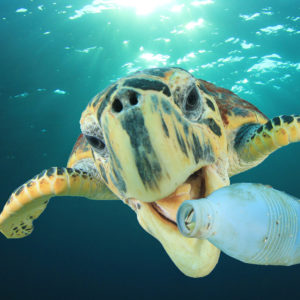Editor’s Note: For an alternative viewpoint, please see: Counterpoint: Plastic Bans Won’t Solve Ocean Plastic Problem
Plastic garbage is steadily accumulating in our oceans. It’s killing marine life and threatening the health of people who eat seafood.
This massive and growing problem demands real solutions. Legislation restricting single-use plastic bags or water bottles is good, but doesn’t go far enough. Ocean cleanup efforts are admirable, yet not up to the enormity of this problem.
What society really needs to do is stop producing so much cheap plastic junk — and stop building factories that convert cheap, fracked natural gas into cheap plastic junk.
Unfortunately the United States is moving in the opposite direction, with a building boom of ethane cracker plants, most of them in Texas and Louisiana. Yet even in conservative, pro-oil Texas, people are alarmed by a proposal to build the world’s largest plastics plant near Corpus Christi.
This joint proposal by Exxon and the Saudi Arabian government got President Trump’s signoff during his trip to the royal kingdom a year ago. Texas is in the process of approving the project and subsidizing it with more than $1 billion in tax breaks.
The plant will “crack” the ethane in natural gas to produce almost 2 million tons of ethylene annually. Ethylene is the basic building block of plastic products. That’s part of a multibillion-dollar push by fossil fuel companies to increase global plastic production by 40 percent over the next decade. Dozens of plastic plants are planned.
Byproducts of the process are massive greenhouse gas emissions and toxic pollution, and the main product is more plastic — none of which society needs right now.
There’s a direct connection between policies that spur overproduction of natural gas and the glut of factories being built to turn that gas into plastic. States that encourage generous taxpayer subsidies of the fossil fuel industry also tend to ignore the damage fracking does to groundwater, wildlife, air quality and climate stability.
This vicious cycle is inviting climate chaos and filling our oceans with plastic. The latest studies by the World Economic Forum estimate that the weight of plastic in our oceans will exceed that of all the fish in the sea by 2050 unless we drastically change our ways.
The Great Pacific Garbage Dump and other ocean gyres where currents make plastics accumulate are visible, growing indicators of the problem. But ocean plastic pollution isn’t just disgusting to look at — it’s also a major threat to public health and the ocean food web.
Plastic pollution remains in our oceans forever, picking up mercury, lead or other toxic compounds along the way.
Little bits of plastic get mistaken for food and eaten by fish, sea turtles, birds and other wildlife. These animals often choke on the items, or experience feelings of fullness and then starve to death. Other animals become entangled in plastic garbage and drown.
One study found that marine plastic pollution affected at least 267 species, including 86 percent of sea turtle species and 43 percent of marine mammal species. Large whales are often found with bellies full of plastic after they die.
Plastic gets eaten by little fish, which get eaten by bigger fish, which often end up on dinner plates. Seafood eaters end up consuming thousands of tiny bits of plastic every year, which stays in our bodies and can affect our health.
This serious problem needs to be confronted in multiple ways. Communities need to ban single-use plastic, as France has. Plastic producers need to be held responsible for the damage done by their products. The apparel industry needs to address the microplastics shed by our clothing, and more municipal water-treatment plants need finer filters to capture those microplastics.
But the biggest thing we can do to reduce ocean plastic pollution over the long term is to produce less plastic. And that starts with opposing the epidemic of new plastic plants and the cheap, fracked natural gas that fuels them.

